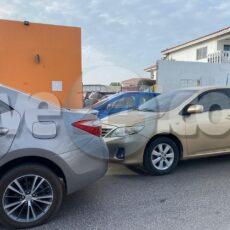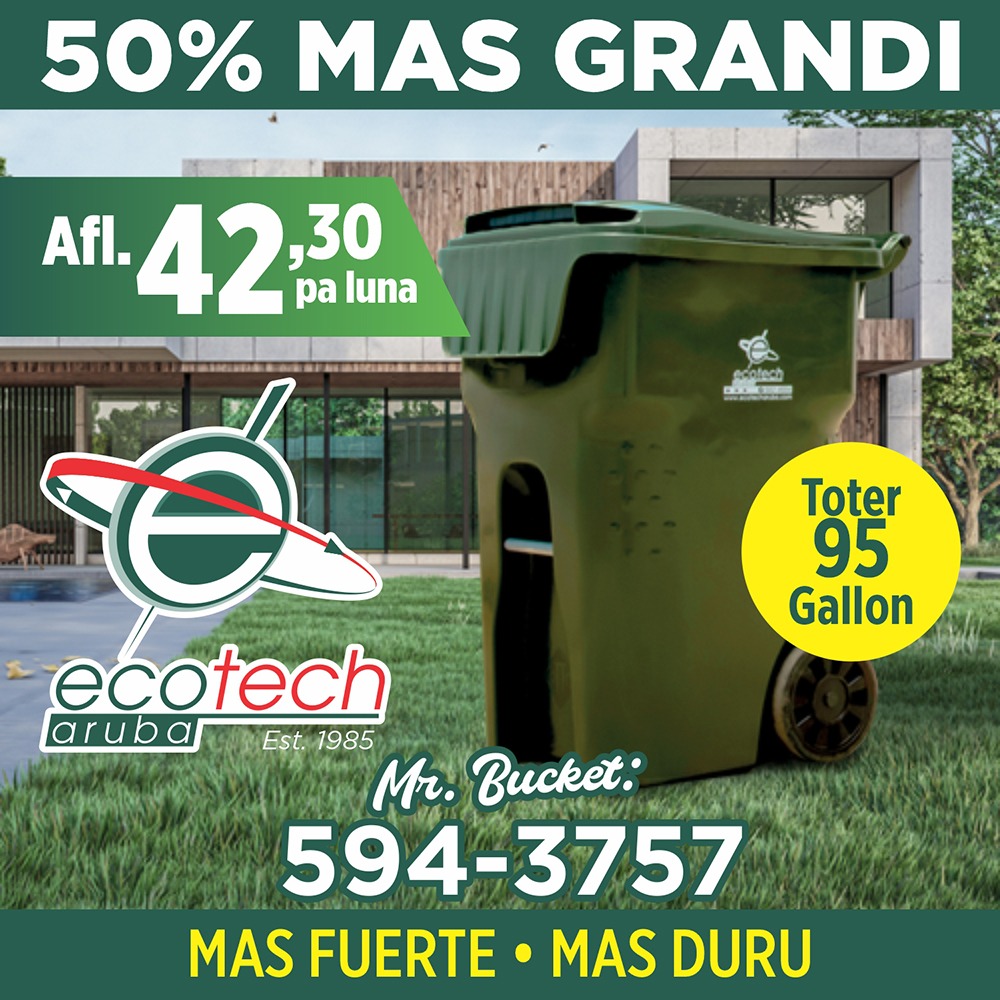
Natuurbehoud staat centraal tijdens “Conservation Week Aruba 2020”
Conservation Work a focal point during Conservation Week Aruba 2020
ORANJESTAD, ARUBA – For di 26 di juli pa 1 di augustus, Fundacion Parke Nacional Aruba (FPNA) ta celebra su prome siman di conservacion, un siman di consentisacion y educacion cu lo wordo ripiti den e añanan nos dilanti.
Natasha Silva, Director di Conservacion, ta splica mas ariba e importancia di un evento asina: “Na FPNA nos a nota un aumento grandi den e interes publico riba e tema relaciona cu naturalesa y sostenibilidad, mientras tambe nos ta nota un aumento den menasanan pa e biodiversidad di nos isla y e conservacion di nos habitat y ecosistemanan.”
Mientras su contesta por sorprede hopi, especialmente unda recientemente a logra proteha 16 reservanan natural, Sra. Silva ta continua bisando: “Lagami splica un poco mas…”
E desafionan ambiental, ambos local y global, a cambia e manera cu nos ta hiba conservacion di naturalesa na un manera drastico durante e ultimo decadanan.
Cu esaki nos ta pensa riba menasanan global manera cambio di clima y acidificacion di nos lama. Na nivel local nos trabou di conservacion ta keda un desafio si nos tuma nota di e aumento den populacion humano y turismo, unda esaki ta pone un presion riba e capacidad di carga di nos isla, deterioracion di tera (erosion, salinacion y perdida di fertilidad di e tera), polucion (aire, awa, tera – incluyendo substancianan toxico), desaroyo di nos costanan, deterioracion di e salud di nos ecosystemanan, sobre pesca, introducion di especienan invasivo manera, tilapia, boa, sapo y perdida di biodiversidad. E lora y paloma azul ta especienan cu a bira extincto na Aruba, e patrishi y conew ta casi bira extincto, sin lubida nos especienan endemic manera e cascabel, prikichi, shoco y varios otro especie di flora y fauna cu ta na peliger di extincion. Sra. Silva ta enfatisa: “Nos mester preveni extincion di nos especienan, cu desaparicion di especienan, nos ta perde un parti importante di nos identidad Arubiano”.
Na mesun momento tin varios rason pa celebra. Siman pasa, 16 reservanan natural nobo a ser traspasa bou maneho di FPNA. Hunto cu areanan protegi, Parke Nacional Arikok, siteo Ramsar Spaans Lagoen, Aruba su areanan protegi ta contene ecosistemanan y habitat importante manera, areanan di duinen cu un vegetacion unico, paisajenan di nos seronan, areanan di awa y rooi, cual ta hogar pa varios especienan endemico y / of especienan cu ta na riesgo di extincion manera, 10 especie di sternchi, raton di anochi, dori, y otro insectonan manera barbulet, y otro polinadornan. Awo mas cu 20% di nos isla ta protegi y FPNA ta maneha tambe 4 “Marine Protected Areas” dentro di e Parke Marino cual ta cubri un total di 6020 hectarea. Maske e por mustra hopi, ta rekeri hopi mas pa asina salvaguardia populacion di flora y fauna cu ta core riesgo di extincion.
FPNA ta trahando pa un tempo caba conhuntamente cu Aruba Birdlife Conservation y Global Owl Project, riba un proyecto di Shoco, y lo continua durante e añanan nos dilanti, desaroyando asina proyectonan di conservacion conhuntamente cu partnernan local y internacional. Trahando hunto ta clave, pero e enfoke riba recuperacion di biodiversidad y mehoracion di e salud di nos ecosystemanan so no ta suficiente.
Sra. Silva ta continua: “Como un comunidad nos mester cambia nos manera di pensa y cuminsa desaroya un comportacion sostenibel. Nos mester mira nos isla como un ecosystema grandi unda nos como humano ta un parti di esaki. Naturalesa no ta simplemente un obheto. Naturalesa ta rondona nos tur, y e ser humano ta un parti crucial pa naturalesa. E manera di pensa aki no ta limita naturalesa pa areanan protegi solamente. Un ehempel di esaki ta cu nos por nota cu cascabel, shoco y prikichi ta wordo mira tambe den areanan cu no ta un reserva natural, pero ta wordo categorisa dentro di e “Spacial Developmen Plan 2019” como ‘Natuur en Landschap’, ‘Landelijk Gebied’ y hasta den areanan urbano. E areanan aki di un forma of otro mester ta conecta cu “Green Corridors” pa asina nos fauna por continua cu nan ritmo y viaha natural. Nos por haci un poco mas tambe unda nos ta hasi areanan urbanisa mas rico den naturalesa. Akinan ta unda nos ta papia den un ekilibrio entre construcion y biba cu naturalesa. “Si nos logra esaki, mi ta kere firmament cu Aruba lo ta un lugar unico y ehempel pa mundo henter”. Ademas, dor di salvaguardia nos recursonan natural lo benificia economia di nos isla. Destrucion continuo di esaki lo tin un impacto negativo ariba nos economia, incluso nos industria di pesca y nos turismo.
Conservation Week Aruba 2020 ta celebra Aruba su naturalesa unico, na un forma diferente, unda lo tin varios evenementonan, presentacion digital cu e expertonan di conservacion di FPNA, un seso sport riba rednan social y lo culmina cu un “Rough Hike” den naturalesa.
FPNA lo sigi stimula consentisacion general y lo continua cu e trabou duro den e añanan nos dilanti, contribuyendo asina na un futuro sostenibel pa Aruba su hendenan. Sra Silva ta termina: “Aruba su naturalesa ta bunita, unico, fragil y diverso. Dor di maneha menasanan, enfocando riba trabounan di conservacion y traha pa un futuro sostenibel ta responsabilidad di nos tur como cuidadano, gobierno, fundacionan, sector priva y comunidad en general.”
Natuurbehoud staat centraal tijdens “Conservation Week Aruba 2020”
ORANJESTAD, ARUBA – Van 26 juli tot 1 augustus viert Fundacion Parke Nacional Aruba (FPNA) haar allereerste Week van de Natuurbehoud, een bewustwordingsevenement dat de natuurbeschermingsorganisatie de komende jaren wil herhalen.
Natasha Silva – Chief Conservation Officer – legt uit waarom een dergelijk evenement belangrijk is: “De afgelopen periode zien we bij FPNA een grote toename van de publieke belangstelling voor natuur- en duurzaamheidsgerelateerde onderwerpen, terwijl we tegelijkertijd getuige zijn van toenemende bedreigingen van de Arubaanse biodiversiteit, ecosystemen en habitats.” Hoewel haar antwoord u misschien zal verrassen, vooral in de feestelijke nasleep van de recente verwerving van 16 nieuwe natuurreservaten, vervolgt mevrouw Silva: “Ik zal het uitleggen …”
De globale en lokale milieuproblematiek heeft de afgelopen decennia ons natuurbehoudswerk drastisch doen veranderen. We hebben te maken met apocalyptische, wereldwijde bedreigingen zoals klimaatverandering en verzuring van de oceaan. Terwijl we op lokaal niveau te maken hebben met een toename van de bevolking en toerisme, het overbelasten van de draagkracht van het eiland, landontginning, woestijnvorming en onttrekking van zoet water, bodemaantasting (erosie, verzilting en verlies van bodemvruchtbaarheid), vervuiling (lucht, water, land – inclusief giftige stoffen), kustontwikkeling, afname van de gezondheid van ecosystemen, ongereguleerd oogsten uit het mariene milieu, introductie van invasieve soorten zoals tilapia, boa en reuzenpadden, en het verlies van biodiversiteit.
De Lora (geelvleugelamazone) en de Paloma Azul (roodhalsduif) zijn al uitgestorven op Aruba, de charismatische Patrishi (gekuifde kwartel) en Conew (katoenstaartkonijn) zijn bijna verdwenen, en iconische endemische soorten zoals Cascabel (Arubaanse ratelslang), Prikichi (Arubaanse maisparkiet), Shoco (Arubaanse holenuil) en talloze soorten flora worden nu bedreigd, sommige zelfs ernstig. Silva benadrukt: “We moeten verdere uitsterven voorkomen, want met het verdwijnen van soorten en habitats verliezen we ook onze Arubaanse identiteit.”
Tegelijkertijd is er reden om te vieren. Afgelopen week zijn 16 nieuwe natuurgebieden onder het beheer van FPNA gekomen. Samen met het voorheen beschermde Arikok Nationaal Park en het Ramsar-gebied Spaans Lagoen, bevatten deze nieuwe beschermde gebieden van Aruba belangrijke ecosystemen en habitats – zoals xerische struikgewas, kwetsbare duingebieden met karakteristieke vegetatie, heuvelachtig landschap, wetlands en afwateringsgebieden – de leefgebieden van vaak kwetsbare, bedreigde en / of endemische soorten, waaronder 10 soorten sternen, vleermuizen, kikkers en talloze insecten zoals vlinders en andere bestuivers. Nu is meer dan 20% van het eiland officieel beschermd en beheert de stichting ook vier ‘Marine Protected Areas’ (MPA’s), die samen de Parke Marino Aruba vormen (6020 hectaren). Hoewel dit veel lijkt, is het hele eiland en het geheel omringende kustzee nodig om te voorkomen dat populaties van flora en fauna uitsterven.
FPNA werkt al samen met Aruba Birdlife Conservation en het Global Owl Project aan een Shoco herstelprogramma en zal de komende jaren doorgaan met het verder ontwikkelen van tal van andere natuurbehoudsprogramma’s – samen met lokale en internationale organisaties. Partnerschap is het sleutelwoord. Echter, enkel werken aan herstel van biodiversiteit en het verbeteren van de gezondheid van ecosystemen is verre van voldoende.
Silva vervolgt: “Als gemeenschap moeten we onze manier van denken veranderen en duurzaam gedrag ontwikkelen. We moeten het eiland gaan zien als één groot ecosysteem en de mensheid als onderdeel van dit systeem. De natuur is niet ‘iets daar buiten.’ De natuur is overal om ons heen en de mens is een integraal onderdeel hiervan. Verder kent de natuur geen grenzen: het beperkt zich niet tot natuurreservaten. Er zijn ook Cascabel, Shoco en Prikichi die buiten onze natuurgebieden leven in gebieden die volgens het nationaal Ruimtelijk Ontwikkelingsplan (2019) zijn aangewezen als ‘Natuur en landschap’, ‘Landelijk gebied’ en zelfs in stedelijke gebieden. Al deze gebieden zouden met elkaar in verbinding moeten worden gebracht door middel van zogenaamde ‘groene corridors’, zodat de wilde dieren hun natuurlijke ritmen kunnen volgen en zich veilig van het ene gebied naar het andere kunnen verplaatsen. Maar we kunnen ook een stap verder gaan en onze stedelijke gebieden natuurrijk inrichten en natuurvriendelijk maken. Dit zou pas echt een verschil uitmaken door te bouwen en te leven MET de natuur. Als we hierin slagen, dan denk ik dat Aruba echt een unieke plek en een voorbeeld voor de wereld zal zijn!”. Silva beweert verder: “Bovendien komt de bescherming van onze natuurlijke hulpbronnen onze economie ten goede. Omgekeerd, het vernietigen ervan zal een negatieve impact hebben op onze economie, inclusief onze visserij en toerisme.”
FPNA’s Week van de Natuurbehoud 2020 viert specifiek de unieke en beschermde natuur van Aruba met verschillende natuurbeschermingsevenementen, een webinar met FPNA’s experts op het gebied van natuurbehoud, een online natuurbeschermingsquiz en een ruige wandeling in het nationale park.
FPNA zal de komende jaren doorgaan met het stimuleren van de bewustzijn, het creëren van een draagvlak voor natuurbehoud en verder werken aan een duurzame toekomst voor de bevolking van Aruba en een veerkrachtige en soortenrijke natuur.
Silva eindigt: “De prachtige, unieke en kwetsbare natuur van Aruba is een algemeen goed. Het aanpakken van de bedreigingen, het bijdragen aan natuurbehoud en het werken aan een duurzame toekomst voor het eiland is in het verlengde hiervan de verantwoordelijkheid van ons allemaal – natuur-NGO’s, overheid, private sector en de gemeenschap als geheel.”
Conservation Work a focal point during Conservation Week Aruba 2020
ORANJESTAD, ARUBA – From the 26 July to 1 August, Fundacion Parke Nacional Aruba (FPNA) celebrates its first ever Conservation Week, an awareness event that the nature conservation organization intends to repeat in the coming years.
Natasha Silva – Chief Conservation Officer – explains why such an event is important: “Well, at FPNA we are noticing an increase in public interest in nature and sustainability related topics, while at the same time we’re witnessing an increase in threats to our island’s biodiversity and the conservation of ecosystems and habitats.”
While her answer may surprise you, especially in the celebratory wake of recently acquiring 16 new nature reserves, Ms. Silva continues with: “Let me explain …”
The current global and local environmental challenges have drastically changed the way we do nature conservation over the last decades. We have to deal with apocalyptic, global threats like climate change and ocean acidification. While at a local level our conservation work is challenged by an increase in the human population and tourism, overstretching the island’s carrying capacity, land conversion, desertification and freshwater withdrawals, soil deterioration (erosion, salinization, and soil fertility loss), pollution (air, water, land – including toxic substances), coastal development, deteriorating ecosystems health, (marine) overharvesting, introduction of invasive species such as tilapia, boa and cane toads, and biodiversity loss.
The Lora (yellow-shouldered parrot) and the Paloma Azul (scaly-naped pigeon) have already become extinct on Aruba, the charismatic Patrishi (crested bobwhite) and Conew (cotton-tailed rabbit) have almost disappeared, and iconic endemic species such as Cascabel (Aruba island rattlesnake), Prikichi (Aruban brown-throated parakeet), Shoco (Aruban burrowing owl) and numerous species of flora are now endangered, some even critically. Ms. Silva exclaims: “We must prevent further extinction, as with the disappearance of species and habitats, we are also losing our Aruban identity.”
At the same time there’s reason to celebrate. Only last week, 16 new nature reserves were brought under the management of FPNA. Together with the previously protected Arikok National Park and Ramsar area Spaans Lagoen, Aruba’s protected areas contain important ecosystems and habitats – such as arid, xeric shrubland, vulnerable dune areas with characteristic vegetation, hilly landscape, wetlands, watershed and drainage areas – which are home to many often vulnerable, endangered, and/or endemic species, including 10 species of terns, bats, frogs and numerous insects such as butterflies and other pollinators. Now more than 20% of the island is officially protected and the foundation also manages four Marine Protected Areas (MPAs) which collectively form the Parke Marino Aruba (6020 hectares). Although this may seem like a lot, the entire island and coastal seas are needed to prevent populations of flora and fauna from going extinct.
FPNA is already working on a Shoco recovery program together with Aruba Birdlife Conservation and the Global Owl Project and will continue the coming years to further develop numerous other conservation programs together with local and international organizations. Partnership is key. However, working on biodiversity recovery and increasing ecosystem health alone is not enough.
Ms. Silva explains: “As a community, we need to change our way of thinking and develop sustainable behaviors. We need to start seeing the island as one big ecosystem and see us humans as part of this system. Nature is not something out there. Nature is all around us and humans are an integral part of nature. This way of thinking does not limit nature to protected areas only. After all, nature does not adhere to human induced boundaries: there are also Cascabel, Shoco and Prikichi living outside of our nature reserves in areas which under the national Spatial Development Plan (2019) are designated as ‘Natuur en landschap’, ‘Landelijk gebied’ and even in urban areas. All these spaces need to be connected by so-called ‘green corridors’, for wildlife to follow their natural rhythms and safely travel from one area to another. However, we can also go a step further and make our urban areas nature rich and nature friendly. This would be truly working towards finding a balance by building and living with nature.” “If we manage to achieve this then I believe that Aruba will be a wonderfully unique place and an example to the world!” Ms. Silva claims. “Moreover, safeguarding our natural resources will benefit our economy. Destroying them will negatively impact our economy, including our fisheries and tourism.”
FPNA’s 2020 Conservation Week specifically celebrates Aruba’s unique and protected nature with several conservation events, a webinar with FPNA’s conservation experts, an online conservation quiz, and a rough hike in the national park.
FPNA will continue stimulating awareness and working hard the coming years towards contributing to a sustainable future for Aruba’s people and a resilient, species-rich and diverse nature.
Ms. Silva ends: “Aruba’s beautiful, unique and fragile nature is a common good. Tackling threats, forwarding nature conservation and working towards a sustainable future is by extension the responsibility of us all: nature NGOs, government, private sector and the community at large”.













